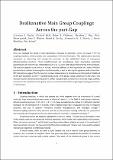Dealkanative main group couplings across the peri-gap
Abstract
Here, we highlight the ability of peri-substitution chemistry to promote a series of unique P–P/P–As coupling reactions, which proceed with concomitant C–H bond formation. This dealkanative reactivity represents an interesting and unexpected expansion to the established family of main-group dehydrocoupling reactions. These transformations are exceptionally clean, proceeding essentially quantitatively at relatively low temperatures (70–140 °C), with 100% diastereoselectivity in the products. The reaction appears to be radical in nature, with the addition of small quantities of a radical initiator (azobisisobutyronitrile) increasing the rate dramatically, as well as altering the apparent order of reaction. DFT calculations suggest that the reaction involves dissociation of a phosphorus centred radical (stabilised by the peri-backbone) to the P–P coupled product and a free propyl radical, which carries the chain. This unusual reaction demonstrates the powerful effect that geometric constraints, in this case a rigid scaffold, can have on the reactivity of main group species; an area of research that is gaining increasing prominence in recent years.
Citation
Taylor , L J , Buehl , M , Chalmers , B A , Ray , M J , Wawrzyniak , P , Walton , J C , Cordes , D B , Slawin , A M Z , Woollins , J D & Kilian , P 2017 , ' Dealkanative main group couplings across the peri-gap ' , Journal of the American Chemical Society , vol. 139 , no. 51 , pp. 18545-18551 . https://doi.org/10.1021/jacs.7b08682
Publication
Journal of the American Chemical Society
Status
Peer reviewed
ISSN
0002-7863Type
Journal article
Description
This work was financially supported by the EPSRC and COST action CM1302 SIPs.Collections
Items in the St Andrews Research Repository are protected by copyright, with all rights reserved, unless otherwise indicated.

